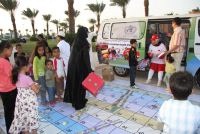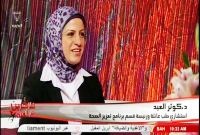Health bus, Bahrain
 Bahrain is a small archipelago with a population of approximately 1 235 000. The health bus aims to provide physical activity opportunities for all children and young people in Bahrain.
Bahrain is a small archipelago with a population of approximately 1 235 000. The health bus aims to provide physical activity opportunities for all children and young people in Bahrain.
The main aim of the project in Bahrain is to enable young people and children to practise physical activity. The project commenced in February 2010 and is ongoing.
Dr Amal Al-Jowder was awarded the Sasakawa Prize for Health Development in May 2009, and used the prize money to fund the Dr Amal bus project. The prize money funded the project for its first year of implementation (2010–2011). The project was funded by the private sector from 2012 to 2013. The Ministry of Health has agreed to sponsor the project in 2014. The lead agency in the project is the Health Promotion Directorate, Ministry of Health and partners include nongovernmental organizations and the private sector.
The project focuses solely on physical activity promotion and is targeted at children and young people, particularly those from low socioeconomic groups.
The health bus visits schools to provide children with opportunities to use a range of equipment including a trampoline, bicycles, balls, skipping ropes, and weight lifting equipment.
Dr Amal, a health promotion specialist, educates the children about the benefits of physical activity and different ways to be active.
The programme also aims to raise awareness among parents.
Dr Amal attends a range of events including World Days related to health.
On national holidays the bus visits public parks and local community settings to promote physical activity.
Evaluation
A satisfaction survey is carried out with the target group and stakeholders.
Monthly statistics are recorded on the number and destination of bus trips.
Key findings
From 2010 to 2013 the bus has undertaken 66 visits to different places and events.
Results from the satisfaction survey indicate high awareness of the bus.
Overall the equipment and activities were deemed appropriate.
Key factors contributing to the success of the project
Children enjoy the wide-range of equipment.
The programme is mobile and can be delivered in a wide range of communities.
The programme has received wide spread support and publicity.
Challenges
Equipment periodically needs replacing.
Limited number of health promotion specialists can travel in the bus and deliver the programme.
No sustainable monitoring and evaluation system.
The promotion of physical activity through the mass media, Bahrain
 The mass media health promotion campaign aims to promote healthy lifestyles such as a healthy diet and physical activity to all citizens of Bahrain. It started in January 2012 and is ongoing.
The mass media health promotion campaign aims to promote healthy lifestyles such as a healthy diet and physical activity to all citizens of Bahrain. It started in January 2012 and is ongoing.
Bahrain is a small archipelago with a population of approximately 1 235 000.
The campaign is funded by the Information Affairs Authority and the Ministry of Health.
The lead agency in this initiative is the Support and Production Unit at the Health Promotion Directorate and partners include Bahrain National Channel Television, Bahrain National Radio and all the newspapers in Bahrain.
The campaign focuses on four aspects of a healthy lifestyle: stress management, healthy diet, avoiding smoking, and physical activity.
The campaign targets the whole population of Bahrain, as well as specific subgroups, including young people, adults, older adults, families, workforce/employees, people with disabilities, women, and the most inactive.
Key components for physical activity
Daily tips are published via social media, including Twitter, Facebook and Instagram
Weekly newspaper articles written by health professionals such as doctors, nutritionists and public health specialists.
Use of relevant websites, including the health promotion directorate and Ministry of Health websites to publish health-related articles and news
The Bahrain National Television and Radio channels are launching a daily programme about health, which includes interviews with health specialists.
The Bahrain National Television Channel is launching a daily short physical activity session in cooperation with the Ministry of Education in which they will demonstrate physical activity exercises for the viewers.
Evaluation: Monthly statistics are used to monitor the channel and topics of health promotion messages. In addition, the directorate publishes an annual report summarizing the quantity of health promotion activities being published via all channels.
Key findings for 2013
- 7212 tips were published via social media, 2315 (32%) of which related to physical activity.
- Health messages were promoted via 30 websites
- 162 radio announcements/interviews were made, 28 (17%) of which specifically related to physical activity.
- 110 health promotion advertisements/interviews were made on television, 20 (18%) of which focused on physical activity
- 71 newspaper articles were published, 11 (16%) of which were about physical activity.
Key factors contributing to the success of the project
The use of social media such as Instagram and Facebook
Support from the media and newspaper organizations
Support of the Ministry of Health via the GCC Award of Excellence.
Challenges
Occasional miscommunication between media officials
Limited free-of-charge space available in newspapers.
For more information:
Al haraka baraka (movement is a blessing) programme, Saudi Arabia

 Aim: The Al haraka baraka (movement is blessing) is a physical activity promotional programme intended to complement the regular school physical education (PE) programme for 6–12 year olds.
Aim: The Al haraka baraka (movement is blessing) is a physical activity promotional programme intended to complement the regular school physical education (PE) programme for 6–12 year olds.
Location: Riyadh is an urban city and the capital of Saudi Arabia. This metropolitan city has a population of over 5 million people.
Duration: The programme commenced in the school year 2004–2005 and was implemented for a 2-year period.
Lead agency: King Saud University.
Partners: Arab Centre for Nutrition.
Key focus: The main aim of the programme was to provide knowledge and skills for students and their teachers on physical activity and health.
Key components for physical activity
- Written resources, a website, and a CD for children and adolescents, their teachers, and families, on the benefits of physical activity and the harmful effects of sedentary behaviours, as well as instructions on how to be active.
- Resources included a parents’ guide, teachers’ guide, and resources for the students themselves.
- The resources focus on three main types of physical activity (enhancing aerobic fitness, strength, and flexibility), as well as avoiding sedentary activities.
- The materials were administered during regular PE classes in schools (at least twice a week) for a 4 to 6 week period.
Evaluation
A pilot study was undertaken towards the end of the first academic year of implementation. The evaluation aimed to assess the suitability of the programme and to gain feedback from teachers, students and the students’ families.
Key findings
- The programme was well accepted by students, students’ families, teachers and schools.
- The programme did not elicit any significant changes in short term physical activity levels of the pupils, however the results of the evaluation indicated that the children became more aware of the importance of physical activity and responded positively to the programme materials.
Key factors contributing to the success of the project
- The project was appealing to both students and teachers because it was different from the regular school PE programme.
- The programme used existing school facilities.
- Families of the students were also involved.
Challenges
- Teachers needed training to administer the programme.
- The programme was delivered over a 4–6 week period. However, implementation over a longer period may be necessary to maximise its effectiveness.
- No funding was available to continue to deliver the programme beyond the initial 2-year period.








